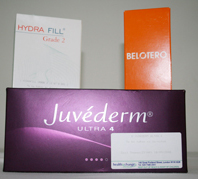- Wrinkles may be proof of wisdom. But do you ever wish you didn’t have to look quite so wise?
Cosmetic fillers are materials injected underneath the skin to make it fuller. After injection, the plumper skin shows fewer wrinkles and looks younger.
Injectable cosmetic fillers have been around for decades. In recent years, medical advances have brought new versions of this wrinkle treatment to the marketplace. Newer cosmetic fillers are longer lasting, even permanent — but do your homework before heading to the cosmetic surgeon.
- How does one get a wrinkle?
Skin is held tight and smooth by three critical components: collagen, hyaluronic acid, and elastin. These chemicals combine to create a firm, spongy meshwork under the skin surface. This elastic structure keeps the skin surface smooth and firm.
We slowly lose the integrity of the meshwork as we age. With weakness in the underlying support structure, the skin’s surface loses its perfect baby-skin smoothness.
Injecting cosmetic fillers helps fill the thinned-out meshwork. They plump up the tissue underneath skin, shrinking wrinkles. The skin becomes firmer, smoother, and younger-looking.
Collagen is the oldest and best-known cosmetic filler. Newer natural and synthetic products are available, each with its own advantages and disadvantages.
- Human Collagen Fillers (Cosmoderm, Cosmoplast)
Human collagen, mass-produced from cultures of human cells, became available in 2002. Human collagen causes dramatically fewer allergic reactions, so skin testing is usually not needed. It is more expensive than bovine collagen, and injections also need to be repeated every three to six months.
- Hyaluronic Acid Fillers (Restylane, Perlane, Esthelis, Juvederm)
 Hyaluronic acid is a naturally occurring polysaccharide (chain of sugars). It’s a normal part of the support structure under the skin. Age depletes hyaluronic acid in the skin, but injections can replace it.Various natural and synthetic hyaluronic acid (HA) products are available. In the newest products, the HA molecule is modified to break down more slowly. Cosmetic results can last nine months or longer. Allergic reactions are very rare.
Hyaluronic acid is a naturally occurring polysaccharide (chain of sugars). It’s a normal part of the support structure under the skin. Age depletes hyaluronic acid in the skin, but injections can replace it.Various natural and synthetic hyaluronic acid (HA) products are available. In the newest products, the HA molecule is modified to break down more slowly. Cosmetic results can last nine months or longer. Allergic reactions are very rare.
- Fat Injection Fillers
Ever wish you could move that fat from your waist to somewhere it might look a little better? Fat injections involve removing small amounts of fat from the thighs, belly, or buttocks and injecting it under the skin of the face. The fat expands the skin, shrinking wrinkles. Because it is your own tissue, there can be no allergic reaction. Results are excellent and long lasting.
- Poly-L lactic Acid (Sculptra) Fillers
When injected under the skin, poly-L lactic acid (PLLA) stimulates skin cells to make collagen. Poly-L lactic acid is nontoxic, and has been widely used as a component of suture material for years.
PLLA is FDA-approved for cosmetic treatment of certain skin conditions in HIV patients. It is often used in persons who have lost a lot of fat from their cheeks giving them a “lean look”. Sculptra is often labelled as “semi-permanent” filler, meaning results can last for months to years.
Calcium Hydroxyapatite (Radiesse) Fillers
In 2006, the FDA approved calcium hydroxyapatite for cosmetic injection. This cosmetic filler is made of the minerals that give bone its strength and texture. These minerals are ground into tiny particles and suspended in water solution, which is injected under the skin.
In the trial that led to its approval, calcium hydroxyapatite worked significantly better and lasted longer than collagen injections to reduce severe wrinkles.
At Juvenis, you can discuss with the dermatologist the filler that will suit your skin the best. Using the right filler and placing it in the right part of your skin can make all the difference between a perfect picture finish and a shabby finish.

